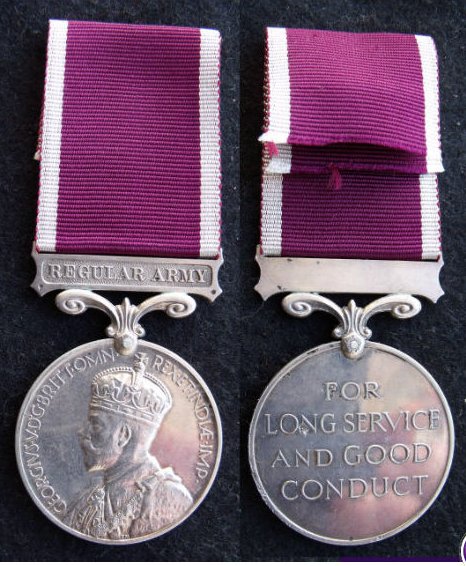Long Service and Good Conduct Medal

The Long Service and Good Conduct Medal was established in 1830 by King William IV to honour soldiers of exemplary conduct who had completed extended periods of service. Originally awarded to infantry soldiers after 21 years and cavalry soldiers after 24 years, the qualifying period was reduced to 18 years for both branches in 1870. During World War II, officers became eligible if they had completed at least 12 of their 18 years of service in the ranks.
Historical Development
- 1830: The original issue featured the Royal Coat of Arms with the badge of Hanover on the obverse and a small suspension ring with a plain crimson ribbon.
- 1831: The small ring was replaced by a larger version.
- 1837: Upon Queen Victoria’s succession, the Hanover emblem was removed from the obverse.
- 1855: During the Crimean War, a swivelling scroll suspension was introduced, echoing the design of the Crimea Medal.
- 1874: The reverse inscription was updated with smaller lettering, replacing the original large type.
- 1901: With King Edward VII’s accession, the obverse began to feature the effigy of the reigning sovereign, a tradition that continued through the reigns of King George V and beyond.
- 1920: The swivelling scroll suspension was replaced by a fixed suspender.
- 1930: The medal was renamed the Long Service and Good Conduct (Military) Medal, and a fixed suspension bar was added, inscribed with either "Regular Army" or the name of a Dominion country such as Australia, New Zealand, Canada, India, or South Africa.
Physical Description Material: Struck in silver. Dimensions: 36 millimetres (1.42 inches) in diameter and 3 millimetres (0.12 inches) thick. Obverse:
- Until 1901: Featured a trophy of arms with the Royal Arms in an oval shield.
- Post-1901: Displayed the effigy of the reigning monarch.
Reverse: Consistently bore the inscription: FOR LONG SERVICE AND GOOD CONDUCT. This was underlined by two spear blades, which evolved from three tied balls to three separate balls between the blades.
Suspension:
- Evolved from small and large rings to a plain curved bar, then to an ornamented scroll pattern.
- The scroll suspender transitioned from a swivelling type to a fixed non-swivelling type.
Ribbon:
- Originally plain crimson, shared with the Victoria Cross (distinguished by a miniature button emblem in undress).
- From June 1916, a new ribbon was introduced—either crimson or reddish violet, edged with 3 mm wide white bands.
- Width varied: 1 inch (25 mm) for early small ring medals, 1¼ inches (32 mm) for later versions.
Rim Inscription: The medal’s rim was impressed with the recipient’s service number, rank, name, and unit.
The following local people received the Long Service Medal.
- Worledge
- John Pooley b. before 1825